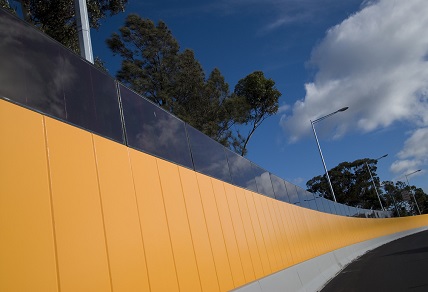Greenhouse reduction
VicRoads is working to reduce our direct greenhouse gas emissions from a range of sources including construction projects. We are also investigating a range of technology options to decrease the indirect greenhouse gas emissions associated with road construction.
Renewable energy
Solar panels currently power some road fixtures, including VicRoads Help Phones, traffic monitoring stations, variable speed signs and school speed zones.
In an Australian first, 210 solar panels were installed along a 500 metre section of the Tullamarine-Calder Freeway noise walls, at Essendon North in 2007.
Renewable energy roadmap
To promote further renewable energy initiatives across the road network, VicRoads has prepared a Renewable Energy Roadmap [PDF 2.3 Mb].
This Renewable Energy Roadmap seeks to provide guidance to VicRoads planners and engineers about the options for greater uptake of renewable energy generation. In doing so, we aim to generate a greater proportion of our electricity from renewable sources to an extent that is cost-effective and technically feasible.
Please contact VicRoads Environmental Strategy at: [email protected] if you require a Microsoft Word format copy of the Renewable Energy Roadmap.
Energy efficient traffic signals & street lights
All new traffic signals and Variable Message Signs use energy efficient Light Emitting Diode (LED) technology, which is up to 40% more efficient than older traffic lights. Most Victorian traffic signals are being progressively retrofitted with LED lanterns.
In 2015, VicRoads Smart Journey Systems trialled energy-efficient LED street lights on the Monash Freeway.
The trial was successful and subsequently led to the replacement of non-energy efficient street lights to LED technology throughout Melbourne Metropolitan area.
In mid-2017, VicRoads Smart Journey Systems commenced the renewal of non-efficient lights to LED technology on our freeways and some declared arterial roads. We also implemented an Asset Monitoring and Control System to proactively monitor and maintain Street Lighting assets with minimal human intervention.
More information can be found on the Department of Treasury and Finance website and GGBP Media Release [PDF 147 Kb]
Please contact VicRoads ITS Street Lighting staff via email: [email protected]
Motor vehicle emissions
The design of roads can help to reduce vehicle emissions. We plan new roads to minimise wear on vehicles so they don't need to work as hard, therefore saving fuel and decreasing pollution.
Techniques to reduce vehicle emissions and impacts include:
- surface treatments for smoother roads
- minimising gradients on new roads
- improving traffic flow at intersections
- using Intelligent Transport Systems (ITS) such as freeway ramp signals
- installing high occupancy transit lanes and transit lanes.
Public transport & bicycles
We have improved roads and facilities to allow a smoother trip for road-based public transport users and cyclists. These improvements include:
- expanding the principal bicycle network
- dedicated bus lanes and intersection signal priority
- clearways
- SmartBus projects
- Doncaster Park and Ride.
Moving towards carbon-neutral road construction
The Mickleham Road duplication project was completed in 2008 at Greenvale. This pilot project was the first to measure the carbon footprint of road construction and identify ways to potentially reduce and offset carbon emissions from roadworks.
Project-generated emissions for this project were offset with carbon credits sourced from an accredited supplier by planting more than 7,000 trees in the north-west Victoria. This equates to offsetting around 2000 tonnes of greenhouse gas.
As Australia's first 'carbon-neutral' road construction project, the learnings from Mickleham Road have been shared with the road construction industry Australia-wide to help generate a national approach.
In collaboration with interstate and overseas road authorities VicRoads has helped develop a common whole-of-life methodology for assessing the greenhouse footprint of road projects.
This has led to the development of CarbonGauge, a tool which assesses the greenhouse footprint of projects and enables options for reducing the footprint to be explored.
More information on the Greenhouse Emissions Assessment Methodology for Road Construction is available by request from VicRoads Environmental Strategy at: [email protected]